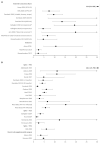What are the risk factors for death among children with pneumonia in low- and middle-income countries? A systematic review
- PMID: 36825608
- PMCID: PMC9951126
- DOI: 10.7189/jogh.13.05003
What are the risk factors for death among children with pneumonia in low- and middle-income countries? A systematic review
Abstract
Background: Knowledge of the risk factors for and causes of treatment failure and mortality in childhood pneumonia is important for prevention, diagnosis, and treatment at an individual and population level. This review aimed to identify the most important risk factors for mortality among children aged under ten years with pneumonia.
Methods: We systematically searched MEDLINE, EMBASE, and PubMed for observational and interventional studies reporting risk factors for mortality in children (aged two months to nine years) in low- and middle-income countries (LMICs). We screened articles according to specified inclusion and exclusion criteria, assessed risk of bias using the EPHPP framework, and extracted data on demographic, clinical, and laboratory risk factors for death. We synthesized data descriptively and using Forest plots and did not attempt meta-analysis due to the heterogeneity in study design, definitions, and populations.
Findings: We included 143 studies in this review. Hypoxaemia (low blood oxygen level), decreased conscious state, severe acute malnutrition, and the presence of an underlying chronic condition were the risk factors most strongly and consistently associated with increased mortality in children with pneumonia. Additional important clinical factors that were associated with mortality in the majority of studies included particular clinical signs (cyanosis, pallor, tachypnoea, chest indrawing, convulsions, diarrhoea), chronic comorbidities (anaemia, HIV infection, congenital heart disease, heart failure), as well as other non-severe forms of malnutrition. Important demographic factors associated with mortality in the majority of studies included age <12 months and inadequate immunisation. Important laboratory and investigation findings associated with mortality in the majority of studies included: confirmed Pneumocystis jirovecii pneumonia (PJP), consolidation on chest x-ray, pleural effusion on chest x-ray, and leukopenia. Several other demographic, clinical and laboratory findings were associated with mortality less consistently or in a small numbers of studies.
Conclusions: Risk assessment for children with pneumonia should include routine evaluation for hypoxaemia (pulse oximetry), decreased conscious state (e.g. AVPU), malnutrition (severe, moderate, and stunting), and the presence of an underlying chronic condition as these are strongly and consistently associated with increased mortality. Other potentially useful risk factors include the presence of pallor or anaemia, chest indrawing, young age (<12 months), inadequate immunisation, and leukopenia.
Copyright © 2023 by the Journal of Global Health. All rights reserved.
Conflict of interest statement
Disclosure of interest: The authors completed the ICMJE Disclosure of Interest Form (available upon request from the corresponding author) and disclose no relevant interests.
Figures



References
-
- World Health Organization. Revised WHO classification and treatment of childhood pneumonia at health facilities: Evidence summaries. Switzerland: WHO; 2014. Available at: https://apps.who.int/iris/bitstream/handle/10665/137319/9789241507813_en.... Accessed:13 February 2023. - PubMed
-
- WHO. Pocket Book of Hospital care for children: guidelines for the management of common childhood illnesses. 2nd ed. Geneva: World Health Organization; 2013. - PubMed
-
- WHO. Integrated Management of Childhood Illness - Chart Booklet. Geneva: World Health Organization (WHO); 2014.
-
- McAllister DA, Liu L, Shi T, Chu Y, Reed C, Burrows J, et al. Global, regional, and national estimates of pneumonia morbidity and mortality in children younger than 5 years between 2000 and 2015: a systematic analysis. Lancet Glob Health. 2019;7:e47-57. 10.1016/S2214-109X(18)30408-X - DOI - PMC - PubMed
Publication types
MeSH terms
LinkOut - more resources
Full Text Sources
Medical
